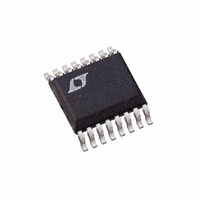LTC1417ACGN Linear Technology, LTC1417ACGN Datasheet - Page 10

LTC1417ACGN
Manufacturer Part Number
LTC1417ACGN
Description
IC A/D CONV 14BIT SAMPLNG 16SSOP
Manufacturer
Linear Technology
Datasheet
1.LTC1417CGNPBF.pdf
(32 pages)
Specifications of LTC1417ACGN
Number Of Bits
14
Sampling Rate (per Second)
400k
Data Interface
MICROWIRE™, Serial, SPI™
Number Of Converters
1
Power Dissipation (max)
27.5mW Unipolar; 44mW Bipolar
Voltage Supply Source
Dual ±
Operating Temperature
0°C ~ 70°C
Mounting Type
Surface Mount
Package / Case
16-SSOP (0.150", 3.90mm Width)
Lead Free Status / RoHS Status
Contains lead / RoHS non-compliant
Available stocks
Company
Part Number
Manufacturer
Quantity
Price
Company:
Part Number:
LTC1417ACGN
Manufacturer:
LT
Quantity:
10 000
Part Number:
LTC1417ACGN
Manufacturer:
LTNEAR
Quantity:
20 000
Company:
Part Number:
LTC1417ACGN#PBF
Manufacturer:
CYPRESS
Quantity:
120
Part Number:
LTC1417ACGN#PBF
Manufacturer:
LINEAR/凌特
Quantity:
20 000
Company:
Part Number:
LTC1417ACGN#TRPBF
Manufacturer:
LT
Quantity:
450
APPLICATIONS
LTC1417
Signal-to-Noise Ratio
The signal-to-noise plus distortion ratio [S/(N + D)] is the
ratio between the RMS amplitude of the fundamental input
frequency to the RMS amplitude of all other frequency
components at the A/D output. The output is band limited
to frequencies from above DC and below half the sampling
frequency. Figure 3b shows a typical spectral content with
a 400kHz sampling rate and a 200kHz input. The dynamic
performance is excellent for input frequencies up to and
beyond the Nyquist limit of 200kHz.
10
Figure 3b. LTC1417 Nonaveraged, 4096 Point FFT,
Input Frequency = 200kHz
Figure 3a. LTC1417 Nonaveraged, 4096 Point FFT,
Input Frequency = 10kHz
–100
–120
–100
–120
–20
–40
–60
–80
–20
–40
–60
–80
0
0
0
0
f
f
SFDR = –98dB
SINAD = 81.1dB
SAMPLE
IN
= 197.949188kHz
U
= 400kHz
50
50
FREQUENCY (kHz)
FREQUENCY (kHz)
INFORMATION
U
100
100
f
f
SFDR = –97.44dB
SINAD = 81.71dB
SAMPLE
IN
= 10.05859375kHz
= 400kHz
150
150
W
1417 G08
1417 G07
200
200
U
Effective Number of Bits
The effective number of bits (ENOBs) is a measurement of
the resolution of an ADC and is directly related to the
S/(N + D) by the equation:
where N is the effective number of bits of resolution and
S/(N + D) is expressed in dB. At the maximum sampling
rate of 400kHz, the LTC1417 maintains near ideal ENOBs
up to the Nyquist input frequency of 200kHz (refer to
Figure 4).
Total Harmonic Distortion
Total harmonic distortion (THD) is the ratio of the RMS
sum of all harmonics of the input signal to the fundamental
itself. The out-of-band harmonics alias into the frequency
band between DC and half the sampling frequency. THD is
expressed as:
where V1 is the RMS amplitude of the fundamental fre-
quency and V2 through Vn are the amplitudes of the
second through nth harmonics. THD vs Input Frequency is
shown in Figure 5. The LTC1417 has good distortion
performance up to the Nyquist frequency and beyond.
ENOB (N) = [S/(N + D) – 1.76]/6.02
THD
Figure 4. Effective Bits and Signal/(Noise + Distortion)
vs Input Frequency
20
14
12
10
8
6
4
2
1k
Log
V
INPUT FREQUENCY (Hz)
2
2
10k
V
3
2
V
1
100k
V
4
2
1417 TA02
Vn
1M
2
86
80
74
68
62
sn1417 1417fas














